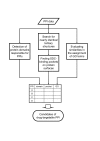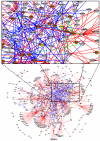An integrative in silico approach for discovering candidates for drug-targetable protein-protein interactions in interactome data
- PMID: 17705877
- PMCID: PMC2045083
- DOI: 10.1186/1471-2210-7-10
An integrative in silico approach for discovering candidates for drug-targetable protein-protein interactions in interactome data
Abstract
Background: Protein-protein interactions (PPIs) are challenging but attractive targets for small chemical drugs. Whole PPIs, called the 'interactome', have been emerged in several organisms, including human, based on the recent development of high-throughput screening (HTS) technologies. Individual PPIs have been targeted by small drug-like chemicals (SDCs), however, interactome data have not been fully utilized for exploring drug targets due to the lack of comprehensive methodology for utilizing these data. Here we propose an integrative in silico approach for discovering candidates for drug-targetable PPIs in interactome data.
Results: Our novel in silico screening system comprises three independent assessment procedures: i) detection of protein domains responsible for PPIs, ii) finding SDC-binding pockets on protein surfaces, and iii) evaluating similarities in the assignment of Gene Ontology (GO) terms between specific partner proteins. We discovered six candidates for drug-targetable PPIs by applying our in silico approach to original human PPI data composed of 770 binary interactions produced by our HTS yeast two-hybrid (HTS-Y2H) assays. Among them, we further examined two candidates, RXRA/NRIP1 and CDK2/CDKN1A, with respect to their biological roles, PPI network around each candidate, and tertiary structures of the interacting domains.
Conclusion: An integrative in silico approach for discovering candidates for drug-targetable PPIs was applied to original human PPIs data. The system excludes false positive interactions and selects reliable PPIs as drug targets. Its effectiveness was demonstrated by the discovery of the six promising candidate target PPIs. Inhibition or stabilization of the two interactions may have potential therapeutic effects against human diseases.
Figures




Similar articles
-
The use of mammalian two-hybrid technologies for high-throughput drug screening.Methods. 2012 Dec;58(4):335-42. doi: 10.1016/j.ymeth.2012.08.003. Epub 2012 Aug 14. Methods. 2012. PMID: 22917772 Review.
-
Discovering reliable protein interactions from high-throughput experimental data using network topology.Artif Intell Med. 2005 Sep-Oct;35(1-2):37-47. doi: 10.1016/j.artmed.2005.02.004. Artif Intell Med. 2005. PMID: 16055319
-
Rationalizing the chemical space of protein-protein interaction inhibitors.Drug Discov Today. 2010 Mar;15(5-6):220-9. doi: 10.1016/j.drudis.2009.11.007. Epub 2009 Dec 5. Drug Discov Today. 2010. PMID: 19969101 Review.
-
Exploring the relationship between hub proteins and drug targets based on GO and intrinsic disorder.Comput Biol Chem. 2015 Jun;56:41-8. doi: 10.1016/j.compbiolchem.2015.03.003. Epub 2015 Mar 23. Comput Biol Chem. 2015. PMID: 25854804
-
Computational probing protein-protein interactions targeting small molecules.Bioinformatics. 2016 Jan 15;32(2):226-34. doi: 10.1093/bioinformatics/btv528. Epub 2015 Sep 28. Bioinformatics. 2016. PMID: 26415726
Cited by
-
IRView: a database and viewer for protein interacting regions.Bioinformatics. 2012 Jul 15;28(14):1949-50. doi: 10.1093/bioinformatics/bts289. Epub 2012 May 15. Bioinformatics. 2012. PMID: 22592381 Free PMC article.
-
Structure and dynamics of molecular networks: a novel paradigm of drug discovery: a comprehensive review.Pharmacol Ther. 2013 Jun;138(3):333-408. doi: 10.1016/j.pharmthera.2013.01.016. Epub 2013 Feb 4. Pharmacol Ther. 2013. PMID: 23384594 Free PMC article. Review.
-
Dr. PIAS 2.0: an update of a database of predicted druggable protein-protein interactions.Database (Oxford). 2012 Oct 10;2012:bas034. doi: 10.1093/database/bas034. Print 2012. Database (Oxford). 2012. PMID: 23060433 Free PMC article.
-
Candidate gene identification approach: progress and challenges.Int J Biol Sci. 2007 Oct 25;3(7):420-7. doi: 10.7150/ijbs.3.420. Int J Biol Sci. 2007. PMID: 17998950 Free PMC article. Review.
-
Integrated Computational Analysis of Genes Associated with Human Hereditary Insensitivity to Pain. A Drug Repurposing Perspective.Front Mol Neurosci. 2017 Aug 8;10:252. doi: 10.3389/fnmol.2017.00252. eCollection 2017. Front Mol Neurosci. 2017. PMID: 28848388 Free PMC article.
References
Publication types
MeSH terms
Substances
LinkOut - more resources
Full Text Sources
Medical

